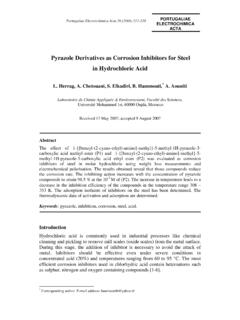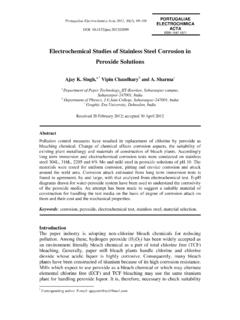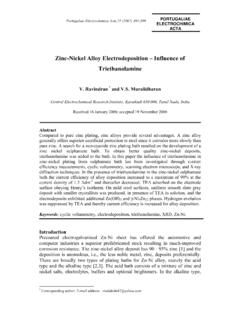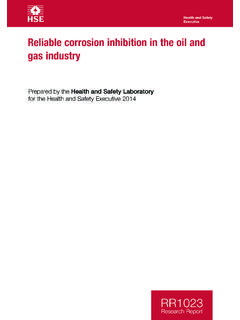Transcription of Cationic Surfactant - Zn Systems as Mixed Corrosion ...
1 Portugaliae Electrochimica Acta 2018, 36(4), 271-283 DOI: PORTUGALIAE ELECTROCHIMICA ACTA ISSN 1647-1571 Cationic Surfactant - Zn+2 Systems as Mixed Corrosion inhibitors for Carbon Steel in a Sodium Chloride Corrosive Medium Reda S. Abdel Hameeda,b,* aFaculty of Science, Department of Chemistry, Al-Azhar University,11884 ,Cairo, Egypt b Department of Chemistry, Faculty of Science, Hail University, 14560, Hail, KSA Received May 13, 2017; accepted September 15, 2017 Abstract Benzyl dimethyl dodecyl ammonium chloride-zinc ion system, as quaternary ammonium salt (QA-Zn+2), was investigated as Corrosion inhibitor for carbon steel in a M sodium chloride solution, by different techniques such as weight loss, open circuit potential, potentiodynamic polarization and electrochemical impedance spectroscopic techniques.
2 The inhibition efficiency of the used system (QA-Zn+2) increases with increasing Mixed inhibitor concentrations and with rising temperatures. A synergistic effect exists between QA and Zn+2. Potentiodynamic polarization curves indicate that the used system mainly acts as an anodic Mixed inhibitor. The polarization resistance values were (Rp) increased, and the interface capacitance (Cdl) was decreased in the Mixed inhibitor system (QA- Zn+2) presence, more than in the case of individual inhibitors . The Corrosion inhibition is due to the adsorption of (QA-Zn+2) onto the metal surface, and the formation of a barrier film that separates the metal from the corrosive medium.
3 The maximum inhibition efficiency of 98% was obtained at 200 QA and 50 ppm Zn+2 of the Mixed inhibitor system, due to a synergistic effect. Keywords: steel Corrosion inhibitors ; Surfactant ; quaternary ammonium salt; synergistic effect; EIS. Introduction Corrosion inhibition of metals and alloys is of technical, economical, and environmental importance. Steel is the backbone of many industries. Corrosion inhibitors are commonly used to reduce Corrosion attack on the steel surface. The presence of the inhibitors leads to a decline in steel Corrosion rate, increasing its lifetime [1-5]. Most of the effective acid inhibitors are organic compounds containing nitrogen, oxygen and /or sulfur, which adsorb onto the steel surface, * Corresponding author.
4 E-mail address: Abdel Hameed / Port. Electrochim. Acta 36 (2018) 271-283 272and hence, slow down the Corrosion rate [1-5]. The strength of adsorption depends on several factors, such as the chemical structure of the inhibitors , the presence of electro donating or electro repelling groups, molecular weight of the inhibitor, and temperature and electrochemical potential at the metal/solution interface [6, 7]. Surfactant inhibitors have many advantages, such as high inhibition efficiency, low price, low toxicity and easy production [8]. The adsorption of the Surfactant onto the metal surface can markedly change the Corrosion resisting property of the metal [9-11]; therefore, studying the relationship between adsorption and Corrosion inhibition is of great importance.
5 Cationic Surfactant compounds show a good Corrosion inhibition of carbon steel [12]. Several surfactants that function as Corrosion inhibitors have biocidal properties; so, they can be used as inhibitors in a petroleum field. As gemini surfactants have got an excellent antimicrobial activity, they are great Corrosion inhibitors for carbon steel in acidic environments, due to the presence of nitrogen and oxygen atoms in their chemical structure [13]. In the work of Abdel Hameed et al. [14], nonionic surfactants derived from plastic waste have been studied as Corrosion inhibitors for mild steel in M NaCl solutions.
6 Weight loss, potentiodynamic polarization techniques and open circuit potential measurements have been used. The aim of the present work is to evaluate the Corrosion inhibition efficiency of benzyl dimethyl dodecyl ammonium chloride, as a Cationic Surfactant towards steel Corrosion in sodium chloride, by determination of its inhibition efficiency in the absence and presence of Zn+2, using chemical (weight loss) and electrochemical techniques, such as open circuit potential, potentiodynamic polarization, and electrochemical impedance spectroscopic techniques. The effect of concentrations and temperatures was studied, and thermodynamic parameters were calculated and discussed.
7 Experimental Materials Benzyl dimethyl dodecyl ammonium chloride and zinc acetate were purchased from Aldrich Chemical Co. Ltd., UK. Sodium chloride (NaCl) was obtained from Shinyo Pure Chemicals ( ). Carbon steel used in this study had the composition (weight %) of C, Mn, P, S, Nb, V, Ti and the remainder Fe. Weight loss techniques For weight loss measurements, a coupon of carbon steel, with the dimensions of 2 cm x 2 cm x cm, was used. The electrode surface was polished with different grades of emery papers, degreased with acetone, and rinsed with distilled water. Pure sodium chloride was used for preparing the corrosive solution.
8 To calculate the accurate values of the percentage inhibition efficiency, three parallel experiments were performed for each test, and the mean value was calculated. Abdel Hameed / Port. Electrochim. Acta 36 (2018) 271-283 273 Open circuit potential The steel electrode potential was measured against a saturated calomel electrode (SCE) in a M NaCl solution, in the absence and presence of different concentrations of the QA-Zn+2 system at 25 C. All measurements were carried out using a multi-tester, until the steady-state potentials would be reached. Potentiodynamic polarization measurements The working electrode was made from a carbon steel rod that had the same composition as mentioned in the subsection Materials.
9 The rod was axially embedded in araldite holder to offer an active flat disc shaped surface with an area of 1 cm2. Prior to each experiment, the working electrode was successively polished with fine emery paper, rinsed with acetone, washed with double distilled water, and finally dried before dipping into the electrolytic cell. A platinum wire was used as counter electrode, and a three compartment cell with a saturated calomel electrode (SCE) was used as reference electrode. The electrochemical experiments were performed using a Voltamaster (PGZ 301, Dynamic Els Voltammetry) analytical radiometer. Under stirring, with a scan rate of 1 mV/s, potential was scanned in the range of -1800 to 0 mV.
10 Synergism parameters Synergism parameter (SI) indicates the synergistic effect existing between inhibitors , if SI value is more than one [15-17]. SI can be calculated from the following relation [16, 17]. SI = (1- 1+2 ) / ( 1- '1+2) (1) where 1+2 = ( 1 + 2) ( 1 x 2), 1 = surface coverage of the QA inhibitor, 2 = surface coverage of the Zn+2 inhibitor, and '1+2 = combined surface coverage of the saturated calomel inhibitor system (QA-Zn+2). Electrochemical impedance spectroscopy (EIS) Electrochemical impedance was obtained using a Voltalab 40 for all EIS measurements, with a frequency range of 100 kHz to 50 mHz, with a 4 mV sine wave as the excitation signal at open circuit potential.










